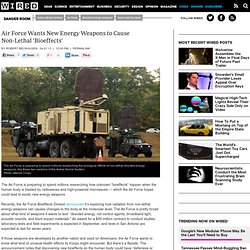

Air Force Wants New Energy Weapons to Cause Non-Lethal 'Bioeffects' The Air Force is preparing to spend millions researching the biological effects of non-lethal directed-energy weapons, like these two versions of the Active Denial System.Photo: Marine Corps The Air Force is preparing to spend millions researching how unknown “bioeffects” happen when the human body is blasted by radiowaves and high-powered microwaves — which the Air Force hopes could lead to exotic new energy weapons.

Recently, the Air Force Bioeffects Division announced it’s exploring how radiation from non-lethal energy weapons can causes changes to the body at the molecular level. The Air Force is pretty broad about what kind of weapons it wants to test: “directed energy, riot control agents, broadband light, acoustic sounds, and blunt impact materials.” An award for a $49 million contract to conduct studies, laboratory tests and field experiments is expected in September, and tests in San Antonio are expected to last for seven years.
Air Force to research non-lethal directed energy weapon ‘bioeffects’ to create new exotic weaponry. Madison RuppertActivist Post While it may sound like complete science fiction, the Air Force is actually preparing to spend $49 million to research the biological effects of non-lethal directed energy weapons in hopes of creating future weapons that manipulate the body on a biochemical or molecular level.

This may sound wildly farfetched but given that the military has researched unbelievable “human enhancement” technologies, weaponized hallucinations, autonomous robotic jellyfish, insect-sized killer drones and fully automated “killer robots,” this shouldn’t be all that surprising. Furthermore, the US military has already developed a wide range of directed energy (DE) weapons ranging from the defunct Airborne Laser program to a “heat ray” and an overall greater emphasis on directed energy weapons of all kinds. “That could mean looking at how concentrated blasts of radio frequency waves and high-power microwaves manipulate our proteins, DNA and metabolites,” Danger Room notes. Laser weapon posts on CNET.
Directed energy experts consider route to acceptance. As the US Navy announces that a high-power solid-state laser is set to be deployed on aboard the USS Ponce next year, the debate over directed energy weapons and systems continues apace.

Last month, the tenth annual Directed Energy Systems (DES) conference, organized by Defence IQ and held in London, heard almost two dozen presentations on all of the key areas around the development of DES. Representatives from the military, academia and several commercial players agreed that in many cases the court is still out on approving laser-based weapons, although there are increasing signs that defensive and civilian deployments of directed energy systems are growing.
Why the Navy Wants to Fall in Love With Laser Weapons. As most of the Pentagon development programs wring their hands with budget worries, there is one area of research that is celebrating a banner week/month—Navy lasers.

"I think directed-energy weapons will change the dynamic of warfare at sea," Rear Adm. Matthew Klunder, chief of naval research, told a crowd at the Navy League's Sea-Air-Space Conference and Exposition this week. It made international news this week when the Navy's Chief of Operations, Adm. Jonathan Greenert, announced the 2014 deployment of a warship to the Persian Gulf—one equipped with a new laser weapon that can burn unmanned aerial vehicles out of the sky. The Pentagon even released a video from a test showing that very act. In another promising, less heralded announcement, the U.S. Why this unabashed love of lasers? Lasers would also be cheaper to operate. The Pentagon funded laser weapons for decades, and that is finally bearing real fruit. Another difficulty is power.
There are policy questions looming as well. U.S. Laser Weapons. In April this year, the US Navy announced plans to deploy a solid state laser on a warship for the first time.

The object is to carry out at-sea demonstration trials on-board USS Ponce – an Afloat Forward Staging Base (Interim) (AFSB [I]) vessel – during the fiscal year 2014, as part of a wider programme of directed energy research. This work has also included the temporary installation of a Laser Weapon System (LaWS), built by the Naval Systems Command aboard the guided-missile destroyer USS Dewey in San Diego in July 2012. The laser in question is a combination system of commercial fibresolid state lasers developed by the Naval Research Laboratory. In an interview with ScienceOmega.com, Dr David C Stoudt, Senior Director for the Naval Capabilities and Readiness Office of the Deputy Under Secretary of the Navy for Plans, Policy, Oversight and Integration, outlines the work being conducted in a concerted effort to put directed-energy weapons (DEWs) into the front line.
Cost effectiveness. Pentagon Wants 'Human Surrogate' for Ray Gun Tests. Test dummies, like this one being used in a Marine Corps first aid exercise, are widely used in both the military and private sector.

Now the Navy wants to use them to test directed-energy weapons. Photo: Marine Corps The Pentagon’s electromagnetic pain weapons are about to make a new friend. It’s an anthropomorphic test dummy that’s gonna get blasted by everything the Pentagon’s non-lethal weapons agency can throw at it. In its latest round of small business research proposals, the Navy announced it’s seeking a sensor-outfitted “human surrogate” for use in an array of non-lethal weapon tests. Eventually, the goal is to “quickly collect data to understand injury potential by detecting, presumably via sensor systems, the effects of various non-lethal stimuli on different parts of the human body,” Alicia Owsiak, deputy chief of the Pentagon’s Joint Non-Lethal Weapons Directorate Technology Division, tells Danger Room in a statement.
That means these dummy people will have dummy organs.